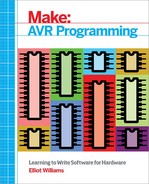Part II. Intermediate AVR
This section makes you a more efficient programmer of the chip and expands the universe of what you’ll think an AVR can do. You’ll start doing cool things with the internal hardware peripherals and some more sophisticated tricks in firmware using what you already know. This section provides the big payoff—the tools to do things with a bare AVR chip that you just can’t do without knowing a little about how the hardware works.
Mastery of microcontrollers starts with good use of the interrupt system. Chapter 8 shows you how to allow events in the outside world to directly and instantaneously call portions of your code. You’ll use this speed to build a noncontact capacitive touch sensor out of aluminum foil and tape that will detect your finger as far as a few centimeters away.
Chapter 9 introduces you to the three internal timers that the ATmega microcontroller comes with. Offloading timing from your code to the timer/counter hardware lets you do things with a precision and speed that you couldn’t before, or even just to do two things at once. Timers are shockingly versatile, and you’ll use them to make a reaction timer, an improved square-wave organ, and even a tiny AM radio transmitter. What do these have in common? Time.
In Chapter 10, you finally get to output something other than ones and zeros from the AVR. (Sort of). Pulse-width modulation (PWM) is the most convenient way to dim LEDs and slow down motors. Between the timer and interrupt hardware, the AVR provides you with a few options for producing PWM, and we’ll go through three.
Servo motors are the perfect match for microcontrollers. For so little circuitry, you get so much movement. In Chapter 11, you’ll use the 16-bit timer to directly control a servo motor with almost no CPU overhead. The project for this chapter is a “sundial” in reverse—instead of the sun creating a moving shadow, you’ll track a laser across the ceiling to show the time. As a bonus, you also get to make a real-time clock out of the AVR.
Rounding out the intermediate section, in Chapter 12 I’ll show you two of my favorite mathematical techniques that help you get more out of the ADC: oversampling and exponential smoothing. These techniques let you build a 12-bit accurate voltmeter and a super-sensitive footstep detector built from a $2 piezo element.
